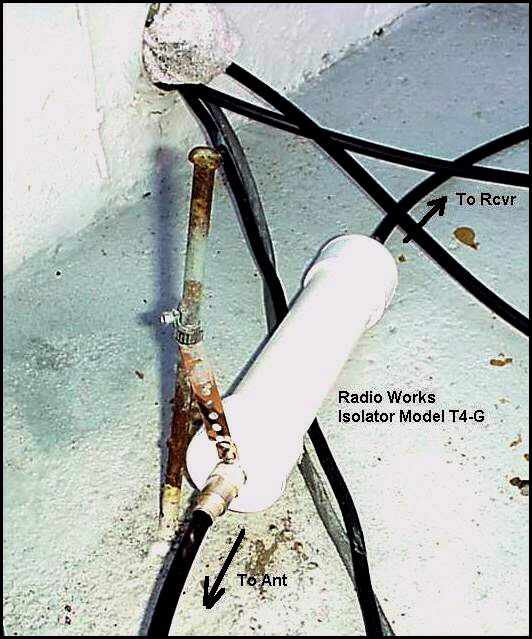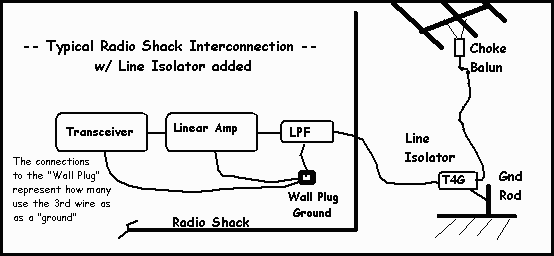|
K6JRF's Page formerly W6FZC ESSB Audio Techniques Page |
(New: Jan 14, 2009)
|
This Technical Note details how to eliminate and/or reduce RFI problems using
a coaxial line isolator. |
|
I guess that we all have RFI problems at one time or another. It goes with the territory. So this note shows how I eliminated my minor RFI problems. I'm a big proponent for the use of the Choke Balun (C/B). It was originally outlined by W2DU and he showed that the problem, namely currents flowing down the outside of the coax, could be prevented. Since them many people have used C/Bs and a number of companies are producing quality products using the W2DU technique. One such company is Radio Works. Click their name to visit the web site. My problem was trivial but it was nonetheless, a problem. In the family room, the Klipsch speakers "grumbled" when I transmitted on 20mtrs. It wasn't that loud and it did NOT get louder w/ the receiver's volume level meaning that the RF was directly rectiying in the speaker w/ the long feed lines as the "medium". My setup is typical of most "shacks". It consists of a FT-2000 driving a AL-572 linear amplifier through a low pass filter via LMR400 coax (100') to a 75mtr rotating dipole (CD78) at 75' with a C/B at the feed point of the dipole. The antenna has a parasitic resonance on 20mtrs so it works nicely there also. This is where the RFI occured; nothing on 75mtrs.
A few days ago, I found that one of my Klipsch speakers was "woofing" RF; it was due to an ohmic solder connection on the crossover board that houses the various filters. After taking the speaker apart, removing the board, resoldering all contacts, the sound returned to that speaker. Now both speakers had a low level grumble on 20mtrs due to direct rectification of the RF. 75mtrs was clean. Then my wife said that she could hear me in the kitchen TV. Sure enough, on 20mtrs there's a grumble but the video was clean. The kitchen TV receives the cable signal via a tap in the main line on the outside of the house. I thought to myself that it would be great to have a "choke" balun with SO-239 connectors on BOTH ends. It should make a great RF "isolator". Then I thought, if a "strap" was added, it would send the RF to ground while the choke portion (hi-impedance) would serve as a line isolator. BION, I did not know that such a device already existed!  After doing a Internet search, I found Radio-Works Line Isolator product, called
T4-G. This model is only for "HF"; they have others that combine HF with
VHF.
After doing a Internet search, I found Radio-Works Line Isolator product, called
T4-G. This model is only for "HF"; they have others that combine HF with
VHF.I installed it today. So that I could be certain that adding it would be the only change, I cut out the length of the T4-G so that the total line length would be identical (about 8") as it was before. It was attached to an existing 6' ground rod which has gotten pretty rusty. After cleaning, the ground-strap from the T4G was attached, the new PL-259 connectors were installed, and the job was done that quickly. Now does it work? [The picture doesn't show the the sealed coax connectors and ground rod attachment] Fired up the station on 20mtrs . . . . and there wasn't a "peep" from anything! Ran 1300 watts into the antenna (CD78) and there wasn't any RFI. . . on anything. The two Klipsch speakers are quiet now! The kitchen TV is also quiet! Repeated on 75mtrs with the same results. Conclusions: 1) The ground rod is the 'best' tool for shunting RF currents on the coax shield to ground. 2) The RF currents on the coax did cause the RFI b/c all is quiet. 3) The coax isolator does work and it works well. It simultaneously blocks and shunts RF coax shield currents from causing RFI. A very worthwhile product. |
 The sketch shows a typical radio installation. The interconnecting coax is short, about 12" and so adding a another
'ground' cable usually does nothing, so it's omitted. Since the RF-ground is usually quite a distance away, the only
ground connection that is used is the ac-power-ground connection.
The sketch shows a typical radio installation. The interconnecting coax is short, about 12" and so adding a another
'ground' cable usually does nothing, so it's omitted. Since the RF-ground is usually quite a distance away, the only
ground connection that is used is the ac-power-ground connection.